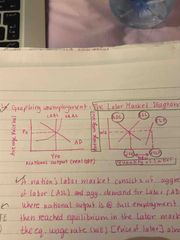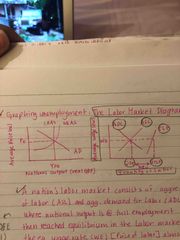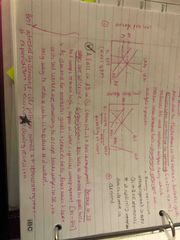![]()
![]()
![]()
Use LEFT and RIGHT arrow keys to navigate between flashcards;
Use UP and DOWN arrow keys to flip the card;
H to show hint;
A reads text to speech;
22 Cards in this Set
- Front
- Back
|
4 Macro Objectives of Governments |
Full employment Low inflation Economic growth Income distribution |
|
|
Unemployment |
A group of people of working age who do not have a job but are available for a job and actively seeking one. |
|
|
UR Equation |
Number of unemployed/labor force |
|
|
Limitations in measuring unemployment |
Hidden unemployment: People who sought employment for a long time but gave up. People who work part time but want a full time job so they’re considered underemployed. People who work for a job below their potential; underemployed. |
|
|
Job dissatisfaction |
Workers’ dissatisfaction with their level of employment or their type is not reflected in the nations employment figures, shortcoming as a measure of the labor forces wellbeing. |
|
|
Distribution of unemployment |
The unemployment values that a country gives is just an average of diff factors masking: -Geographical disparities -Age disparities -Ethnic differences -Gender differences |
|
|
Graphing unemployment: the labor market diagram |

Back (Definition)
|
|
|
Description of Labor market diagram |
A nations labor market consists of aggregate supply of labor (ASL) and agg. demand for labor (ADL). An economy where national output is @ YFE has reached equilibrium in the labor market meaning that at eq wage rate everyone who wants a job has one. |
|
|
Doesn’t mean no unemployment.. |
Natural rate! Structural, seasonal and frictional unemployment. |
|

|
Producing at YFE, price level is stable corresponds with wage level (WE) where everyone employed except NRU. Total labor force (TLF) is greater than ASL since there will always be NRU. |
|
|
TLF is upward sloping |
Because as wage rates in the economy rise members of working age pop not in labor force are incentivized to join. At lower wages members of LF may leave and pursue informal unemployment (continued education..) |
|
|
Difference between Qfe and Qtlf |
Natural rate of unemployment |
|
|
Why do governments want to decrease unemployment?
|
Because those people just suck up money and resources without doing anything. We are producing within the PPC since gov has less income but still have to spend on unemployment benefits and they can’t pay taxes. |
|
|
Economic consequences |
Loss of GDP, loss of tax revenue, increased costs of unemployment benefits and loss of income for individuals. |
|
|
Individual consequences |
Decreased household income Increased levels of psychological and physical illness. |
|
|
Social consequences |
Downward pressure on wages for the employed (more available labor=lower price leveled) Increased poverty and crime Transformation of traditional societies (can cause large scale migration) |
|
|
Specific economic consequences |
Lower level of AD Under utilization of nations resources Brain drain (skilled workers leaving causing PP to fall) Protectionism Increased budget deficit since they don’t pay income tax but get benefits |
|
|
Types of unemployment |
Frictional Seasonal Cyclical Structural |
|
|
Frictional unemployment |
Due to transition phase from one job to another; temporary and voluntary. |
|
|
Structural |
When a worker loses his job due to the changing structure of the nationals economy as the makeup of the GDP changed |
|
|
Cyclical |
Workers who’s skills are in demand but lose their jobs due to a fall in total demand for the nations goods and services. Occurs due to contractions in spending readying AD and real GDP falls which makes labor demand fall and cause downward price pressure. |
|
|
Shifts in labor diagram |

|

